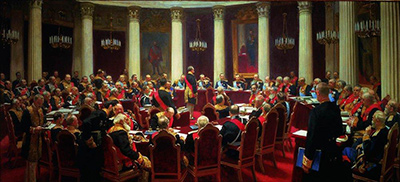The state council that had been founded by Tsar Alexander 1 decided to celebrate its centenary in May 1901 in St. Petersburg, Russia. Ilya Repin produced this stunning portrait painting to mark the event, naming it Ceremonial Meeting of the State Council.
All the attendees of the ceremonial meeting of the state council attended the sitting in a common uniform. This was when Ilya Repin decided to grab the chance and paint the scene as it was. He quickly sketched the details on a canvas and later turned the study into a large image. Looking closely at the picture, it is easy to notice that the members of the council are depicted naturally and in diverse poses with a similar physical resemblance. Born in August 1844 in Ukraine, Repin was a renowned talented painter who was, at some point, held by the Soviet government to be imitated in his state of artistry by the school of socialist realists.
Repin's talent took him to Paris, Italy and impressionist exhibitions, and despite being exposed to so many colours and brush strokes, he could not let go of his unique form of realism. He stuck to paintings of common people, including his contemporary compatriots, the Russian elite, biblical characters, Tsar Nicholas II, intelligentsia, among others. One of the themes that seemed to feature often on his paintings is the Russian revolutionary movement, and for this, his works were regarded as the Russian national style. Unlike many Russian artists, Repin was known to be very hard-working, and before he died, left a diverse artistic legacy. Critics accused him of inconsistency, but he shrugged it off and carried on with what he believed in. With his boundless working capacity, he created great masterpieces, but the following three were not an easy task.
The Religious Procession
In this procession, the crowd is unmatched, and on one hand, is a line rolling like a wave. In the crowd, it is easy to pick out several people with each image carrying a bright personality. It is in this painting that Repin brings out the true character of every individual with some faces expressing fatigue, others are feigned, and one can also notice humility and emptiness.
The Reply of the Cossacks
This is a painting that tells a fictional episode. The Turkish Sultan had asked the Cossacks to surrender, but they instead sent their reply to the Sultan with strong words, but the letter did not in real life exist. After the historical events where the Cossacks gave many problems to the Sultan, this is when the letter was invented. It is said that the letter was read aloud in the presence of Repin where he then decided to create a painting of what he heard. The painting he created was derived from the images of real people, and some were well known in Russia.
Terrible Ivan and His Son Ivan
This was a real historical event that Repin chose to paint where the Russian Ivan kills his eldest son out of rage. At its site, the painting looks scary, depicting the terrible Tsar as crashed and embracing his son whom he had struck and wounded severely. The dead face is brought out as smiling, showing that forgiveness had taken place or he was just happy that he had died in the arms of his father. This painting was dedicated to Tsar Alexander II who had been assassinated in 1881 by the reform movement.
Repin's Creativity
Despite being a high-profile artist, he was known for his contradictions. At some point, he was creating masterpieces on social statements while also crafting several detailed portraits of historical paintings and Russian intellectuals bringing out sympathy for the ruling elite. With the limited number of people whose portraits he painted, Repin was slow and careful, and he persistently looked for new techniques to give his work more depth. He seemed to have a great sense of purpose in all his aesthetics and could even sense the age of his characters. His artistic work was strongly influenced by spiritual and social experiences, as well as the national culture. He liked to base his work on dramatic conflicts that were drawn from the contemporary life, and he also included mythological images. Repin was never satisfied with his work even after being praised by those who saw it, and so he would repaint multiple versions years apart.




